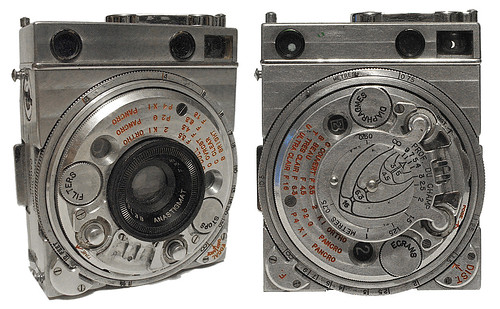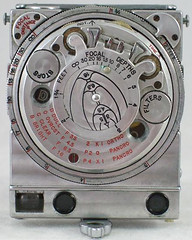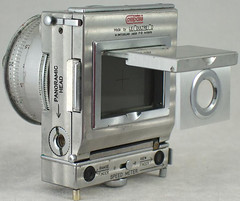Difference between revisions of "Compass"
(image added) |
m (Minor caption edit) |
||
| (22 intermediate revisions by 6 users not shown) | |||
| Line 1: | Line 1: | ||
| − | |||
{{Flickr_image | {{Flickr_image | ||
| − | |image_source= http://www.flickr.com/photos/24225011@N04/2571623854/in/pool- | + | |image_source= http://www.flickr.com/photos/24225011@N04/2571623854/in/pool-camerawiki |
|image= http://farm4.static.flickr.com/3086/2571623854_93d8ed7afe.jpg | |image= http://farm4.static.flickr.com/3086/2571623854_93d8ed7afe.jpg | ||
| − | |image_align= | + | |image_align= right |
| − | |image_text= Compass Camera - lens extended<br> | + | |image_text= Compass Camera - lens extended<br><small>image by ebayer [http://myworld.ebay.co.uk/old_devil Old_devil], used by permission.{{with permission}}</small> |
| − | }} | + | }}The '''Compass Camera''' was manufactured by the Swiss watch-makers Le Coultre et Cie for the Compass Cameras Ltd., based in London. It was conceived and designed by Noel Pemberton Billing, an airman and Member of Parliament. The camera was launched in March 1937, and it was at least available in London until 1941. |
| − | The '''Compass Camera''' was | + | |
| − | It | + | ===Description=== |
| − | + | It is a rectangular aluminium-bodied [[rangefinder camera]], made for 24×36mm exposures on plates. The body is machined from a solid block of aluminium, measuring a mere 30 ×53 ×70mm (1¼;×2<sup>1</sup>/<sub>8</sub>×2¾in) in size with the lens closed, weighing 220g (7¾oz). Special 8-exposure films were available, and later also an [[828 film|828 roll film]] back, made by T. A. Cubitt. | |
| − | + | ||
| − | an [[828 film|828 roll film]] back, made by | + | In 1939 an improved model, the Compass II, was introduced. It was offered as a free upgrade to original Compass owners<ref>Auer, Michel, ''The Illustrated History of the Camera, from 1839 to the present'', Fountain Press, 1975</ref>. About 5000 cameras in total were made before production was prevented by war.<ref>Coe, Brian, ''"Cameras, from Daguerreotypes to Instant Pictures"'', p.128, Marshall-Cavendish/Nordbok 1978; Coe's drawing shows an example labelled in German; from casual observation, this seems to be unusual, and most are in English, but [http://www.submin.com/large/collection/compass/index.htm submin.com] shows German and French, as well as the majority English models.</ref> |
| − | T. A. Cubitt. About 5000 were made before production was prevented by war.<ref>Coe, Brian, ''"Cameras, from Daguerreotypes to Instant Pictures"'', p.128, Marshall-Cavendish/Nordbok 1978; Coe's drawing shows an example labelled in German; from casual observation, this seems to be unusual, and most are in English, but [http://www.submin.com/large/collection/compass/index.htm submin.com] shows German and French, as well as the majority English models.</ref> | ||
| − | The Compass | + | The Compass is extraordinarily well-equipped for such a small package; it has two optical viewfinders, one at a right-angle, a ground glass focusing screen with a folding [[loupe]], a built-in lens cap, three filters, an [[light meter|extinction meter]] and a spirit level. There is also a rotating fitting for the tripod bush in the base with five click stops allowing for panoramic and stereo pictures. The shutter ran from 4½s-1/500s. |
| − | The retractable lens | + | The retractable lens is a 35mm f3.5 Kern anastigmat with a shutter speeded from 4.5s. to 1/500s. |
The Compass was available in a kit, which could include a small, elegant tripod, fitted with a pocket clip, a cable-release, a small leather case or a larger fitted box taking the accessories. | The Compass was available in a kit, which could include a small, elegant tripod, fitted with a pocket clip, a cable-release, a small leather case or a larger fitted box taking the accessories. | ||
| Line 23: | Line 21: | ||
|- valign=top align=center | |- valign=top align=center | ||
||{{Flickr_image | ||{{Flickr_image | ||
| − | |image_source= http://www.flickr.com/photos/24225011@N04/2570798975/in/pool- | + | |image_source= http://www.flickr.com/photos/24225011@N04/2570798975/in/pool-camerawiki |
|image= http://farm4.static.flickr.com/3259/2570798975_4eda967ac5_m.jpg | |image= http://farm4.static.flickr.com/3259/2570798975_4eda967ac5_m.jpg | ||
|image_align= left | |image_align= left | ||
| Line 30: | Line 28: | ||
|| | || | ||
{{Flickr_image | {{Flickr_image | ||
| − | |image_source= http://www.flickr.com/photos/24225011@N04/2571624594/in/pool- | + | |image_source= http://www.flickr.com/photos/24225011@N04/2571624594/in/pool-camerawiki/ |
|image= http://farm4.static.flickr.com/3177/2571624594_2004097e7a_m.jpg | |image= http://farm4.static.flickr.com/3177/2571624594_2004097e7a_m.jpg | ||
|image_align= left | |image_align= left | ||
|image_text= front, closed | |image_text= front, closed | ||
| + | }} | ||
| + | |rowspan=2| | ||
| + | {{Flickr_image | ||
| + | |image_source= http://www.flickr.com/photos/gunthert/2391291155/in/pool-camerawiki | ||
| + | |image= http://farm4.static.flickr.com/3103/2391291155_ae6bd94979.jpg | ||
| + | |image_align= left | ||
| + | |image_text= on Compass tripod | ||
| + | |image_by= André Gunthert | ||
| + | |image_rights= with permission | ||
}} | }} | ||
|- | |- | ||
|| | || | ||
{{Flickr_image | {{Flickr_image | ||
| − | |image_source= http://www.flickr.com/photos/24225011@N04/2571624346/in/pool- | + | |image_source= http://www.flickr.com/photos/24225011@N04/2571624346/in/pool-camerawiki/ |
|image= http://farm4.static.flickr.com/3044/2571624346_40dd88d094_m.jpg | |image= http://farm4.static.flickr.com/3044/2571624346_40dd88d094_m.jpg | ||
|image_align= left | |image_align= left | ||
| Line 45: | Line 52: | ||
|| | || | ||
{{Flickr_image | {{Flickr_image | ||
| − | |image_source= http://www.flickr.com/photos/24225011@N04/2571624100/in/pool- | + | |image_source= http://www.flickr.com/photos/24225011@N04/2571624100/in/pool-camerawiki/ |
|image= http://farm4.static.flickr.com/3071/2571624100_936a5603fc_m.jpg | |image= http://farm4.static.flickr.com/3071/2571624100_936a5603fc_m.jpg | ||
|image_align= left | |image_align= left | ||
| Line 52: | Line 59: | ||
|- | |- | ||
|colspan=2 align=center valign=top| | |colspan=2 align=center valign=top| | ||
| − | + | <small>images by ebayer [http://myworld.ebay.co.uk/old_devil Old_devil], used by permission.{{with permission}}</small> | |
|} | |} | ||
{{Flickr_image | {{Flickr_image | ||
| − | |image_source= http://www.flickr.com/photos/ricksoloway/2212276524/in/pool- | + | |image_source= http://www.flickr.com/photos/ricksoloway/2212276524/in/pool-camerawiki |
|image= http://farm3.static.flickr.com/2360/2212276524_39d5d5d2db.jpg | |image= http://farm3.static.flickr.com/2360/2212276524_39d5d5d2db.jpg | ||
|image_align= right | |image_align= right | ||
| − | |image_text= Compass | + | |image_text= Compass, English- and French-labelling |
| + | |image_by= Rick Soloway | ||
| + | |image_rights= with permission | ||
}} | }} | ||
| − | === | + | ==Notes== |
| + | <references /> | ||
| + | |||
| + | == Links== | ||
* [http://www.submin.com/large/collection/compass/index.htm Compass camera] on [http://www.submin.com/ submin.com] | * [http://www.submin.com/large/collection/compass/index.htm Compass camera] on [http://www.submin.com/ submin.com] | ||
| − | * [http://www.ukcamera.com/classic_cameras/coul1.htm Compass] on ukcamera.com | + | * [https://web.archive.org/web/20180504091207/http://www.ukcamera.com/classic_cameras/coul1.htm Compass] on [https://web.archive.org/web/20191002075926/http://ukcamera.com:80/ UKCamera.com (archived)] |
| − | + | * [http://butkus.org/chinon/compass_camera/compass_camera.htm Compass PDF instruction manuals] on [http://butkus.org/chinon www.orphancameras.com] | |
| + | * [http://www.earlyphotography.co.uk/site/entry_C12.html Compass II] on [http://www.earlyphotography.co.uk/ EarlyPhotography.co.uk] | ||
[[Category: C]] | [[Category: C]] | ||
[[Category: 1937]] | [[Category: 1937]] | ||
| + | [[Category: Switzerland]] | ||
Latest revision as of 06:05, 21 August 2023

|
| Compass Camera - lens extended image by ebayer Old_devil, used by permission.(Image rights) |
The Compass Camera was manufactured by the Swiss watch-makers Le Coultre et Cie for the Compass Cameras Ltd., based in London. It was conceived and designed by Noel Pemberton Billing, an airman and Member of Parliament. The camera was launched in March 1937, and it was at least available in London until 1941.
Description
It is a rectangular aluminium-bodied rangefinder camera, made for 24×36mm exposures on plates. The body is machined from a solid block of aluminium, measuring a mere 30 ×53 ×70mm (1¼;×21/8×2¾in) in size with the lens closed, weighing 220g (7¾oz). Special 8-exposure films were available, and later also an 828 roll film back, made by T. A. Cubitt.
In 1939 an improved model, the Compass II, was introduced. It was offered as a free upgrade to original Compass owners[1]. About 5000 cameras in total were made before production was prevented by war.[2]
The Compass is extraordinarily well-equipped for such a small package; it has two optical viewfinders, one at a right-angle, a ground glass focusing screen with a folding loupe, a built-in lens cap, three filters, an extinction meter and a spirit level. There is also a rotating fitting for the tripod bush in the base with five click stops allowing for panoramic and stereo pictures. The shutter ran from 4½s-1/500s.
The retractable lens is a 35mm f3.5 Kern anastigmat with a shutter speeded from 4.5s. to 1/500s.
The Compass was available in a kit, which could include a small, elegant tripod, fitted with a pocket clip, a cable-release, a small leather case or a larger fitted box taking the accessories.
|
|
| ||||||
|
| |||||||
|
images by ebayer Old_devil, used by permission.(Image rights) | ||||||||

|
| Compass, English- and French-labelling image by Rick Soloway (Image rights) |
Notes
- ↑ Auer, Michel, The Illustrated History of the Camera, from 1839 to the present, Fountain Press, 1975
- ↑ Coe, Brian, "Cameras, from Daguerreotypes to Instant Pictures", p.128, Marshall-Cavendish/Nordbok 1978; Coe's drawing shows an example labelled in German; from casual observation, this seems to be unusual, and most are in English, but submin.com shows German and French, as well as the majority English models.




